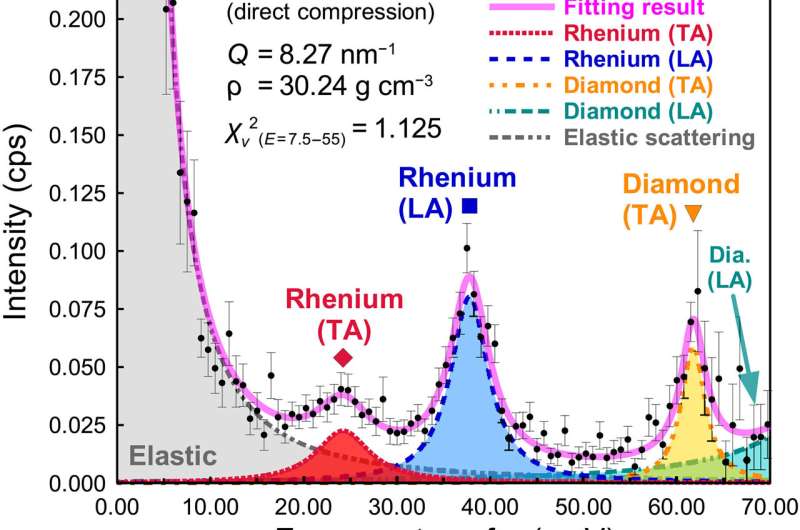This article has been reviewed according to Science X's editorial process and policies. Editors have highlighted the following attributes while ensuring the content's credibility:
fact-checked
peer-reviewed publication
trusted source
proofread
Synchrotron studies change understanding of the composition of Earth's core

In work published in Science Advances, a team of researchers have determined a new pressure scale, which is critical for understanding the Earth's composition.
Using X-rays from a uniquely powerful spectrometer at RIKEN's SPring-8 Center they avoided some of the large approximations of previous work, discovering that the previous scale overestimated pressure by more than 20% at 230 gigapascals (2.3 million atmospheres)—a pressure reached in Earth's core. This is similar to someone running a marathon that they thought was 42 kilometers, but finding they had only really run 34 kilometers. While 20% might seem like a modest correction, it has big implications.
An accurate pressure scale is critical for understanding the composition of the Earth. In particular, the core composition is hotly debated as it is important both for understanding our planet at present, and for understanding the evolution of the solar system in the distant past. While it is generally accepted that the core is mostly iron, evidence from tracking the propagation of seismic waves from earthquakes suggests the core also contains lighter material.
When the new scale was used to interpret the seismological model, the team found that the amount of light material in the inner core is about double what was previously expected, and indeed the total mass of light material in the entire core is probably five times, or more, that of the Earth's crust—the layer that we live on.
In the new work, the team, led by Alfred Q.R. Baron of the RIKEN SPring-8 Center, and Daijo Ikuta and Eiji Ohtani of Tohoku University, used Inelastic X-ray Scattering (IXS) to measure the sound velocity of a rhenium sample under pressure. A tiny rhenium sample (<0.000000001 grams = 1 nanogram) was put under extreme pressure by crushing it between two diamond crystals in a Diamond Anvil Cell (DAC).
The cell was placed in the large IXS spectrometer at BL43LXU and small (~1 ppm) shifts in the energy of the X-rays scattered from the rhenium were carefully measured, allowing the researchers to determine the sound velocity of the rhenium. They determined both compressional/longitudinal and shear/transverse sound velocities, and the density of the rhenium. That allowed the researchers to determine the pressure that the rhenium was subjected to.
The new study provides a direct relationship between rhenium density and pressure. Baron says, "The density of rhenium at high pressure is straightforward and fast to measure, and there are many facilities worldwide where such measurements can be made. However, measuring the sound velocity is much more difficult, and, at these pressures, is probably only practically possible using RIKEN's spectrometer at BL43LXU of SPring-8." The team has done the heavy lifting so that other scientists can now use a much easier-to-measure density to determine pressure.
As Ikuta, Ohtani, and Baron say, "When we used our new scale to interpret the behavior of metallic iron under high pressure and compared it with the seismic model of the Earth, we found that the light material hidden in the inner core is probably about double what was previously expected. Similar changes, perhaps even larger in magnitude, may be expected in considering the structure of other planets. Our work also suggests reassessment of the pressure dependence of nearly all material properties that have been measured at pressures similar or larger than that of the Earth's core."
More information: Daijo Ikuta et al, Density deficit of Earth's core revealed by a multimegabar primary pressure scale, Science Advances (2023). DOI: 10.1126/sciadv.adh8706
Journal information: Science Advances
Provided by RIKEN




















